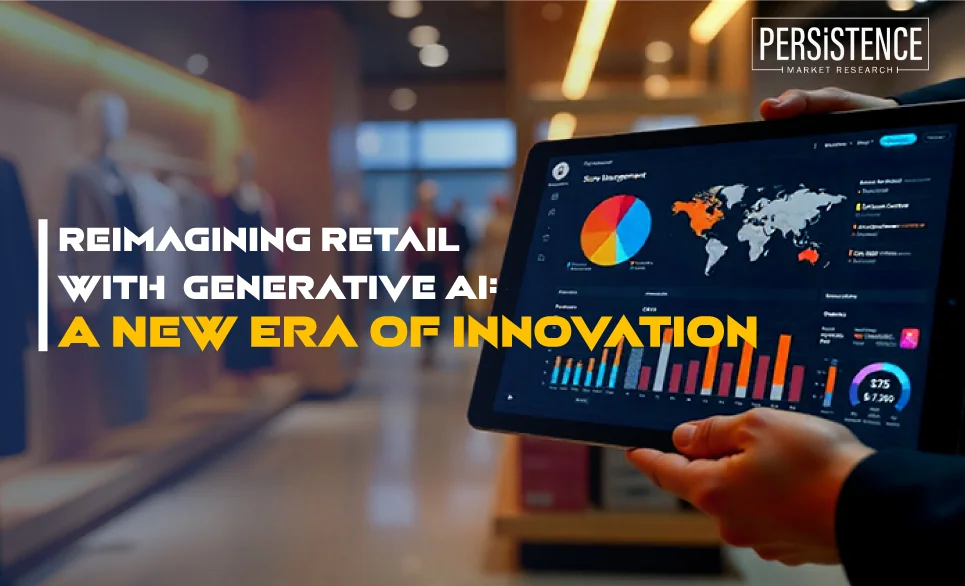- Blog
- Generative Ai Innovation
Reimagining Retail with Generative AI: A New Era of Innovation
Published On : 25 Jul 2025
Generative AI is a sophisticated subset of artificial intelligence designed to create new content based on prompts or data inputs. Unlike traditional AI, which may only analyze or classify data, generative AI can produce human-like text, images, videos, audio, and code. It leverages advanced models such as Large Language Models (LLMs), generative adversarial networks (GANs), and natural language processing to generate realistic and context-specific outputs. For example, AI platforms like ChatGPT can engage in conversational text generation, while tools from Adobe and Canva can alter and enhance images dynamically.

The Transformative Impact of Generative AI on Retail
Generative AI is not just another technological trend-it is reshaping retail operations, customer engagement, and strategic decision-making. Retailers worldwide, from Amazon and Shopify to Indian heavyweights like Flipkart, are adopting generative AI to create personalized shopping experiences, optimize supply chains, and automate content generation. This technology helps businesses deliver personalized product recommendations, design innovative displays, generate marketing content automatically, and even assist employees with real-time insights.
Key Uses of Generative AI in Retail
- Personalized Product Recommendations- By analyzing vast amounts of customer data, including past purchases, browsing habits, and preferences, generative AI helps retailers offer uniquely tailored product suggestions. This personalization significantly improves customer satisfaction and repeat purchases.
- Automated Content Generation- Retailers like Shopify use AI to create product descriptions, email subject lines, and online store content, automatically saving time and ensuring consistent brand messaging.
- Enhanced Marketing and Advertising- AI-generated images and text enable more engaging advertisements, such as transforming standard product photos into lifestyle images that resonate better with consumers, increasing conversion rates.
- Operational Efficiency- Generative AI supports inventory optimization, supply chain management, and store operation decisions by analyzing large data sets and generating actionable insights, boosting profitability along the entire retail value chain.
- Virtual Shopping Assistants- Tools like eBay’s ShopBot use conversational AI to guide customers through massive product catalogs with voice, text, or photo input, improving the shopping journey through precise, human-like interaction.
How does generative AI enhance personalization in retail?
Generative AI analyzes diverse customer signals like previous purchases, search queries, demographic data, and even real-time interactions to create individually curated product recommendations and marketing messages. This leads to a highly relevant shopping experience that feels tailored, helping customers discover products aligned with their tastes and needs. Companies like Stitch Fix have perfected this by generating personalized style profiles that reflect individual preferences based on feedback and purchase history. By making shopping more personal, retailers increase customer loyalty and sales conversion rates.
What operational benefits can retailers expect from adopting generative AI?
Beyond customer-facing applications, generative AI streamlines retail operations by automating repetitive tasks such as content creation and data analysis, enabling faster, more informed decisions. It helps optimize product display designs, pricing strategies, and inventory management.
For example, in-store AI assistants provide employees with personalized guidance on daily tasks, improving efficiency, and customer service.
Challenges of Generative AI in Retail
While the benefits are significant, retailers must carefully manage data privacy, quality, and ethical considerations when using generative AI. Risks include generating inaccurate or plagiarized content if models are not properly supervised and relying on incomplete or biased data that may misinform predictions. Retailers should establish strong data management practices, comply with regulations, and continuously monitor AI outputs. Balancing automation with human oversight remains crucial to ensure AI empowers staff rather than replaces them, preserving trust and the customer experience.
The high implementation cost is also a major barrier, as deploying these technologies demands substantial infrastructure investments, specialized talent, and ongoing training. Generative AI’s effectiveness hinges on having high-quality, diverse data. Poor or fragmented data often leads to inaccurate outputs and suboptimal results, undermining performance. Therefore, retailers must also focus heavily on data management, privacy safeguards, and ethical oversight to successfully harness generative AI.
Looking Ahead: The Future of Generative AI in Retail
As generative AI technology matures, its integration into retail will deepen, creating new revenue streams and operational models. Retailers who adopt AI-driven personalization, automate creative processes, and harness analytics for smarter inventory and supply chain management will gain a competitive advantage. The focus will increasingly be on seamless, interactive shopping experiences where AI serves as the backbone for both customer engagement and strategic decision-making.
Generative AI is poised to become an essential tool in retail, enhancing productivity, fostering loyalty, and enabling retailers to better anticipate and respond to market demands, all while delivering shopping experiences that customers value deeply.
Embracing generative AI is not just about technology adoption but about reshaping retail for a data-driven, customer-centric future.
Industry Report

Artificial Intelligence As A Service Market
181 Pages |24 Jul 2024
Format: PDF, Excel, PPT*
Request Report Sample
Your privacy is important to us; your data is secure
Contact Us
Latest Reports
-
Piezoresistive Pressure Sensor Market by Sensor Type (Absolute, Gauge, Differential, Sealed), Pressure Range (Low Pressure (<10 kPa), Medium Pressure (10 kPa – 1000 kPa), High Pressure (>1000 kPa)), End-Use Industry (Automotive & Transportation, Industrial Manufacturing, Healthcare, Aerospace & Defense, Electronics) and Regional Analysis for 2026-2033
-
Aquarium Accessories Market by Product Type (Filtration Items, Lights & Hoods, Temperature Control Systems, Others), End-User (Residential, Commercial), Distribution Channel (Online, Offline), and Regional Analysis for 2026-2033
-
Oxygen Therapy Market by Product Type (Compressed Oxygen, Concentrated Oxygen, Liquid Oxygen), Disease (Respiratory Disorder, Cardiovascular Disease, Sleep Apnea, Pneumonia), End-User (Hospitals, Home Healthcare, Clinics), and Regional Analysis for 2026-2033
-
Air Curtains Market by Product Type (Non‑Recirculating, Recirculating, Heated, Others), Airflow Capacity (Up to 500 m³/h, 500–1000 m³/h, 1000–1500 m³/h, Above 1500 m³/h), Application (Commercial, Industrial, Residential, Others), and Regional Analysis for 2026–2033
-
Personalized Stationery Market by Product type (Storage & Filling Products, Paper-Based Products, Drawing & Writing Instruments, Accessories, Bags, Others), Application (Educational Institutes, Corporate Offices, Personal Use, Hospitals, Others), and Regional Analysis for 2026–2033
